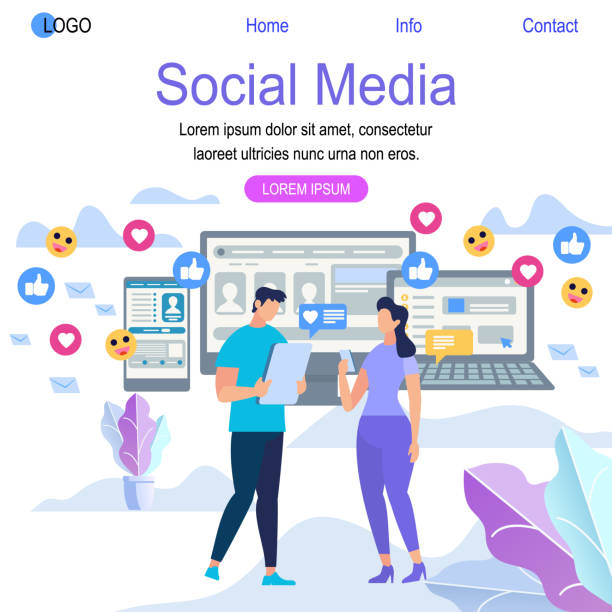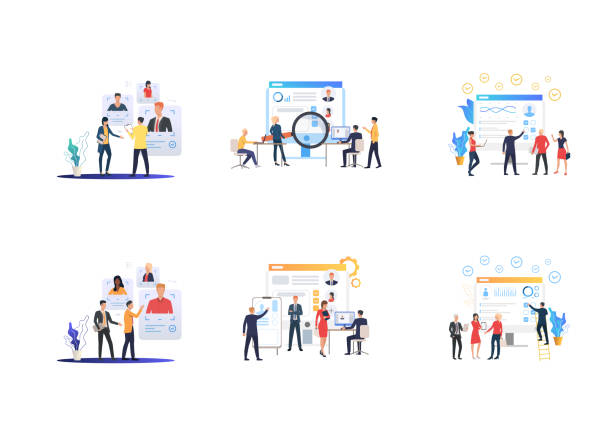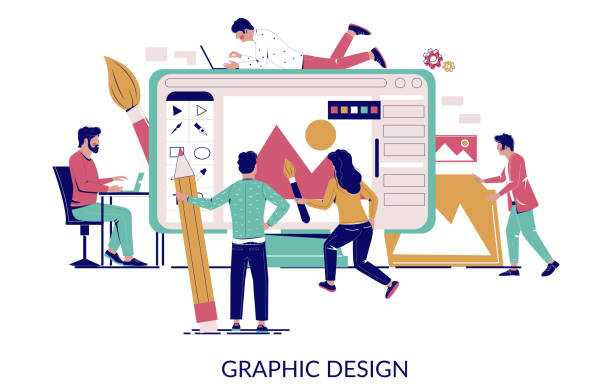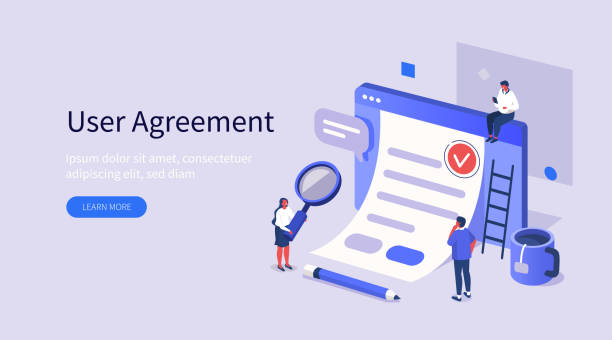Introduction to the Importance of User-Friendly Website Design

In today’s highly competitive world, merely having a website is not enough.
What distinguishes you from competitors is the user experience you provide to your audience.
User-friendly website design is a key concept that focuses on users’ needs and expectations, aiming to create a space that is easy to navigate, pleasant, and efficient.
This approach is not limited to visual aesthetics but also includes information architecture, ease of access, loading speed, and interactivity.
The importance of #user_friendly_design is that it can increase your website traffic, improve conversion rates, and ultimately contribute to better search engine rankings.
A non-user-friendly website can quickly frustrate users, causing them to leave your website and look for alternatives.
This not only harms your brand’s credibility but also eliminates significant business opportunities.
In fact, the more comfortably and satisfactorily users interact with your site, the higher the likelihood of their return and conversion into loyal customers.
This section, in an explanatory and educational manner, lays the foundation for this topic.
Understanding this initial concept is essential for anyone intending to enter the world of digital marketing or optimize their website.
Remember that the success of a website is tied to user satisfaction, and a user-friendly website design is the key to this success.
Did you know that a poor corporate website costs you many opportunities daily? Solve this problem forever with professional corporate website design by Rasaweb!
✅ Create a powerful and trustworthy image for your brand
✅ Targeted attraction of new customers and increased sales
⚡ [Receive free website design consultation]
Key Principles of User Experience in Web Design

To create a user-friendly website design, understanding the fundamental principles of User Experience (UX) is essential.
These principles go beyond mere aesthetics and address how users interact with the website and how they feel during this process.
One of the most important principles is easy and intuitive navigation.
Users should be able to easily find what they are looking for without having to search extensively or guess.
The structure of menus, internal links, and search functionality should be clear and logical.
Another principle is consistency and integrity in design; meaning UI elements, fonts, colors, and layouts should be uniform across the website.
This consistency makes users feel more familiar and comfortable, and understanding how the site works becomes easier for them.
Also, feedback is another vital principle.
The website should respond to user actions, whether through changing a button’s color upon click or displaying a confirmation message after submitting a form.
This feedback assures the user that their actions have been registered and the website is functioning correctly.
Efficiency and effectiveness are also of high importance; meaning users should be able to perform their tasks with minimal effort and in the shortest possible time.
This section, in a specialized and educational manner, provides practical solutions for implementing these principles to optimize your site’s user experience and have more satisfied users.
Adhering to these principles is the cornerstone of any successful user-friendly website design and helps you create an effective and pleasant digital platform for your audience.
By implementing these, you take steps towards having a user-friendly website design.
The Role of Visual Design and Layout in User Experience

Visual design and page layout are vital elements in creating a user-friendly website design.
Aesthetics, color harmony, appropriate font selection, and the organization of elements on the page all influence how users perceive your website and can generate feelings of trust or frustration in them.
Text readability and clarity are of high importance.
Choosing appropriate fonts, sufficient font size, optimal color contrast between text and background, and effective use of whitespace all help users easily read and understand your content.
A cluttered website filled with dense information can exhaust and dishearten users.
Visual Hierarchy also plays an important role; this means guiding the user’s eye towards the most important elements of the page through the use of size, color, and position.
For example, main headings should be larger and more prominent than normal text.
Using high-quality and relevant images and videos can enhance visual appeal and convey your message more effectively.
In user-friendly website design, every visual element should have a purpose and contribute to the overall user experience.
The table below illustrates some visual design principles for improving user experience:
| Visual Design Principle | Explanation | Example in Website Design |
|---|---|---|
| Contrast | Difference between elements for emphasis | Dark text on a light background; distinctly colored buttons |
| Whitespace | Empty space between elements to improve readability | Spacing between paragraphs; page margins |
| Repetition | Repeating visual elements to create consistency | Consistent use of an icon or button style |
| Alignment | Aligning elements to create order and structure | Left or right text alignment; regular columns |
| Proximity | Grouping related elements together | Placing a form label near its input field |
These principles provide practical guidelines for creating an attractive yet functional user interface that leads to high user satisfaction.
The content of this section is specialized and guidance-oriented, helping you take a closer look at the visual details of your site to achieve a truly user-friendly website design.
With implementing these, you take steps towards having a user-friendly website design.
Content Strategy for Attracting and Retaining Users

Content is the heart of every website, but for a website to be truly user-friendly website design, its content must be properly planned and presented.
Content strategy is not just about writing text; it includes defining content goals, understanding the audience, choosing the right format, and organizing it.
Does your content answer users’ questions? Does it meet their needs? Your content should be valuable, accurate, and relevant.
Use short sentences and small paragraphs to make it easier to read.
Using headings, lists, and highlighting keywords significantly increases readability and helps users quickly find the information they need.
Tone and writing style are also important; is it formal or friendly? Does it align with your brand identity? Engaging and attractive content can invite users to interact more and keep them on your site for longer periods.
Furthermore, optimizing content for search engines (SEO) is also part of the content strategy that helps your site get seen.
A user-friendly website design cannot survive without excellent content.
Content management involves regularly updating information, removing old content, and adding new material to keep your website fresh and dynamic.
Consider what questions your audience might have and write your content in a way that answers those questions.
This section combines thought-provoking content and guidance to improve the quality of your website’s content, helping you achieve a truly user-friendly website design.
Ensure that every word on your site serves the goal of user-friendly website design.
Does your company’s website create a professional and lasting first impression in the minds of potential customers? Rasaweb, with professional corporate website design, not only represents your brand’s credibility but also paves the way for your business growth.
✅ Create a powerful and trustworthy brand image
✅ Attract target customers and increase sales
⚡ Receive free consultation
The Importance of Responsive Design and Accessibility

In today’s era, where the use of mobile devices for internet access is increasing, Responsive Design is no longer considered an advantage but a necessity for any user-friendly website design.
Responsive design means that your website should automatically adjust its layout and element sizes to the user’s screen size (whether mobile, tablet, laptop, or desktop) to provide an optimal user experience on any device.
This not only leads to user satisfaction but is also vital for SEO, as search engines rank responsive websites higher in their results.
Beyond that, the topic of Accessibility is also of high importance.
A truly user-friendly website design is one that is usable by everyone, including people with disabilities.
This includes providing alternative text for images (alt text) for visually impaired users, supporting keyboard navigation for users who cannot use a mouse, and ensuring sufficient color contrast for users with low vision.
WCAG (Web Content Accessibility Guidelines) standards are international guidelines for achieving web accessibility.
Ignoring these aspects not only loses a large group of potential audiences but can also lead to legal issues.
This section, in a specialized and explanatory manner, shows you how to expand your audience reach by implementing these approaches and create a truly inclusive user-friendly website design that is usable by everyone.
Paying attention to these points ensures that your site provides an optimal and efficient experience for all users in any situation and is recognized as a user-friendly website design.
The Importance of User Research and Testing in UX Improvement

To ensure that your user-friendly website design is truly effective, you cannot rely solely on guesswork.
User Research and User Testing are two powerful tools that help you understand the real needs, behaviors, and problems of your users.
User research involves gathering information about your target audience through methods such as surveys, interviews, and analysis of existing data.
This stage helps you build user personas and form hypotheses about how they interact with your website.
After that, user testing comes into play; in this stage, real users interact with your website while you observe their behavior and collect their feedback.
This can include usability tests, A/B testing, or even card sorting for optimizing information architecture.
The results of these tests can reveal hidden weaknesses in your user-friendly website design and provide valuable guidance for improvement.
For example, you might find that users have trouble finding a particular button or that the meaning of a phrase on your site is confusing to them.
This process is iterative and continuous; you design, test, learn, and then redesign.
This cycle ensures that your website is continuously evolving and improving to provide the best possible experience for users.
This section, in an educational and analytical manner, highlights the importance of these processes and provides guidance for conducting effective research and tests so that your user-friendly website design is shaped by real data, not just personal assumptions.
A successful user-friendly website design is always learning and adapting.
The Importance of Website Speed and Performance in UX

Your website’s loading speed is one of the most important factors in determining the quality of a user-friendly website design.
In today’s world, where users are accustomed to fast information, even a few seconds of loading delay can lead to lost visitors and reduced conversion rates.
Research shows that most users expect a website to load in under three seconds, and any delay beyond that can cause frustration and site abandonment.
This not only affects the direct user experience but also impacts SEO, as search engines like Google consider site speed a significant ranking factor.
Image optimization, using GZIP compression, reducing HTTP requests, utilizing a CDN (Content Delivery Network), and optimizing CSS and JavaScript codes are among the actions that can significantly improve your website’s loading speed.
Tools like Google PageSpeed Insights can help you evaluate your site’s performance and identify weaknesses.
A user-friendly website design must ensure that users do not need to wait to access content.
This section, in a specialized and explanatory manner, guides you on how to optimize your site’s user experience by improving technical performance.
The table below refers to some critical website speed metrics and their importance:
| Speed Metric (Core Web Vitals) | Explanation | Importance for UX |
|---|---|---|
| LCP (Largest Contentful Paint) | Time required to load the largest visual element on the page | Indicates the time the user sees the main content |
| FID (First Input Delay) | Time from the first user interaction to browser response | Degree of site responsiveness to user input |
| CLS (Cumulative Layout Shift) | Amount of unexpected layout shifts on the page | Prevents unpleasant visual shifts during loading |
| FCP (First Contentful Paint) | Time required to render the first content on the page | The first visual indication to the user that the page is loading |
Paying attention to these technical metrics is crucial for any user-friendly website design and directly impacts user satisfaction and search engine rankings.
Speed is a fundamental pillar of user-friendly website design.
Call to Action and Increasing Conversion Rate

The ultimate goal of many websites is to convert visitors into customers, subscribers, or to perform a specific action.
In a user-friendly website design, a Call to Action (CTA) plays a pivotal role.
CTAs are buttons or links that invite users to perform a specific action, such as “Shop Now”, “Sign Up”, “Read More”, or “Contact Us”.
Effective CTA design is crucial for increasing the Conversion Rate.
This includes choosing persuasive words, using attractive and high-contrast colors for prominence, and placing them in strategic locations on the page.
A CTA should clearly state its purpose and tell the user what to expect when clicking on it.
Do you want users to subscribe to your newsletter? Place a clear and accessible “Subscribe to Newsletter” button.
Do you want to sell a product? The “Add to Cart” button should be prominent and visible.
Furthermore, the User Journey should be designed to naturally guide users towards CTAs.
The content before the CTA should create value for the user and persuade them to take action.
This section, in an analytical and guiding manner, shows you how to significantly improve your website’s performance by optimizing CTAs and the entire conversion process.
It is important to remember that every user-friendly website design should guide users towards your business goals, without pressuring or confusing them.
A/B testing on different CTAs can provide valuable insights into what works best for your audience and help you achieve your website’s maximum potential.
This approach is the foundation of any successful user-friendly website design that leads to tangible results.
Are you falling behind in competition with large online stores?
Rasaweb, with professional e-commerce website design, brings your business online and increases your market share!
✅ Increase brand credibility and customer trust
✅ Easy shopping experience leads to more sales
⚡ Act now to receive free website design consultation!
The Future of User Experience and New Trends

The world of user-friendly website design and user experience is constantly evolving.
Keeping up with new trends is essential for maintaining competitiveness and providing the best possible user experience.
One of the most important future trends is the use of Artificial Intelligence (AI) and Machine Learning (ML) in personalizing user experience.
Websites will be able to dynamically adjust content and offers based on users’ previous behavior.
This can lead to a highly customized and more relevant experience.
Voice User Interfaces (Voice UI) are also growing, especially with the increased use of voice assistants.
Optimizing websites for voice search and offering voice interactive capabilities can add a new dimension to user-friendly website design.
Augmented Reality (AR) and Virtual Reality (VR) also have the potential to change how we interact with the web, especially in areas like e-commerce and entertainment.
Furthermore, an increased focus on sustainability and green design is expected in web development, with websites that consume less energy.
Microinteractions – small animated details that give feedback to the user – will also continue to improve interaction and visual appeal.
User-friendly website design in the future will move further towards intuition, predictability, and empathy with the user.
Understanding and integrating these trends can help you build a website that is not only suitable for today but also ready for future challenges and opportunities.
This section, in a news and entertaining manner, provides a glimpse into what lies ahead and prepares you for the next generation of web design to have a leading user-friendly website design.
Measuring Success and Continuous Improvement

After implementing a user-friendly website design, your work does not end.
In fact, this is just the beginning of a continuous process: measuring success and continuous improvement.
To ensure that your website continues to meet user needs and achieve your business goals, you must regularly evaluate its performance.
Web Analytics, using tools like Google Analytics, provides valuable information about user behavior.
You can monitor metrics such as Bounce Rate, time spent on site, pages visited, conversion paths, and exit rates.
These data show you how users interact with your site and where they might encounter problems.
In addition to quantitative data, qualitative feedback from users is also crucial.
This can be collected through in-site surveys, feedback forms, or even direct interviews with users.
This feedback helps you understand the “why” behind the data.
Based on this data and feedback, you can make the necessary changes and then test again.
This agile and iterative approach ensures that your user-friendly website design always remains optimized.
Continuous improvement not only helps retain current users but also attracts new ones, as a dynamic and responsive website inspires more trust.
This section, in an analytical and guiding manner, emphasizes the importance of continuous monitoring and optimization for maintaining superiority in the online space and shows how a user-friendly website design requires continuous attention and care.
Remember that your success depends on providing a user-friendly website design that is constantly evolving.
Frequently Asked Questions
And other services of Rasa Web Advertising Agency in the field of advertising
Smart Website Development: A professional solution for user interaction with a focus on SEO-driven content strategy.
Smart Advertising Campaign: A blend of creativity and technology to increase site traffic through an SEO-driven content strategy.
Smart Sales Automation: A fast and efficient solution for campaign management focusing on marketing automation.
Smart Sales Automation: A dedicated service for digital branding growth based on precise audience targeting.
Smart Sales Automation: Professional optimization for online growth using user experience customization.
And over hundreds of other services in the field of internet advertising, advertising consultation, and organizational solutions
Internet Advertising | Advertising Strategy | Advertorial
Resources
Key Tips in User-Friendly Website Design
The Impact of UI/UX on Your Site’s Success
Complete Guide to User Experience Design
The Relationship between SEO and User-Friendly Design
? For your business leap in the digital world, Rasaweb Afarin is your partner. From modern UI website design to professional SEO optimization, we offer comprehensive solutions for your growth and visibility.
📍 Tehran, Mirdamad Street, next to Central Bank, Southern Kazerun Alley, Ramin Alley No. 6


